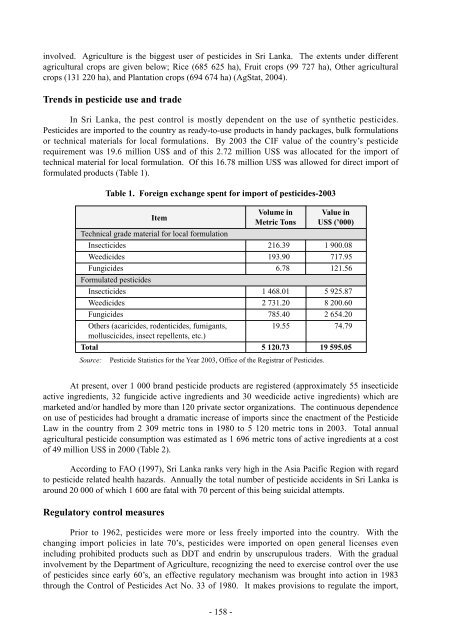Proceedings of the Asia regional workshop on the
Proceedings of the Asia regional workshop on the
Proceedings of the Asia regional workshop on the
Create successful ePaper yourself
Turn your PDF publications into a flip-book with our unique Google optimized e-Paper software.
involved. Agriculture is <str<strong>on</strong>g>the</str<strong>on</strong>g> biggest user <str<strong>on</strong>g>of</str<strong>on</strong>g> pesticides in Sri Lanka. The extents under different<br />
agricultural crops are given below; Rice (685 625 ha), Fruit crops (99 727 ha), O<str<strong>on</strong>g>the</str<strong>on</strong>g>r agricultural<br />
crops (131 220 ha), and Plantati<strong>on</strong> crops (694 674 ha) (AgStat, 2004).<br />
Trends in pesticide use and trade<br />
In Sri Lanka, <str<strong>on</strong>g>the</str<strong>on</strong>g> pest c<strong>on</strong>trol is mostly dependent <strong>on</strong> <str<strong>on</strong>g>the</str<strong>on</strong>g> use <str<strong>on</strong>g>of</str<strong>on</strong>g> syn<str<strong>on</strong>g>the</str<strong>on</strong>g>tic pesticides.<br />
Pesticides are imported to <str<strong>on</strong>g>the</str<strong>on</strong>g> country as ready-to-use products in handy packages, bulk formulati<strong>on</strong>s<br />
or technical materials for local formulati<strong>on</strong>s. By 2003 <str<strong>on</strong>g>the</str<strong>on</strong>g> CIF value <str<strong>on</strong>g>of</str<strong>on</strong>g> <str<strong>on</strong>g>the</str<strong>on</strong>g> country’s pesticide<br />
requirement was 19.6 milli<strong>on</strong> US$ and <str<strong>on</strong>g>of</str<strong>on</strong>g> this 2.72 milli<strong>on</strong> US$ was allocated for <str<strong>on</strong>g>the</str<strong>on</strong>g> import <str<strong>on</strong>g>of</str<strong>on</strong>g><br />
technical material for local formulati<strong>on</strong>. Of this 16.78 milli<strong>on</strong> US$ was allowed for direct import <str<strong>on</strong>g>of</str<strong>on</strong>g><br />
formulated products (Table 1).<br />
Table 1. Foreign exchange spent for import <str<strong>on</strong>g>of</str<strong>on</strong>g> pesticides-2003<br />
Item<br />
- 158 -<br />
Volume in Value in<br />
Metric T<strong>on</strong>s US$ (’000)<br />
Technical grade material for local formulati<strong>on</strong><br />
Insecticides 216.39 1 900.08<br />
Weedicides 193.90 717.95<br />
Fungicides 6.78 121.56<br />
Formulated pesticides<br />
Insecticides 1 468.01 5 925.87<br />
Weedicides 2 731.20 8 200.60<br />
Fungicides 785.40 2 654.20<br />
O<str<strong>on</strong>g>the</str<strong>on</strong>g>rs (acaricides, rodenticides, fumigants,<br />
molluscicides, insect repellents, etc.)<br />
19.55 74.79<br />
Total 5 120.73 19 595.05<br />
Source: Pesticide Statistics for <str<strong>on</strong>g>the</str<strong>on</strong>g> Year 2003, Office <str<strong>on</strong>g>of</str<strong>on</strong>g> <str<strong>on</strong>g>the</str<strong>on</strong>g> Registrar <str<strong>on</strong>g>of</str<strong>on</strong>g> Pesticides.<br />
At present, over 1 000 brand pesticide products are registered (approximately 55 insecticide<br />
active ingredients, 32 fungicide active ingredients and 30 weedicide active ingredients) which are<br />
marketed and/or handled by more than 120 private sector organizati<strong>on</strong>s. The c<strong>on</strong>tinuous dependence<br />
<strong>on</strong> use <str<strong>on</strong>g>of</str<strong>on</strong>g> pesticides had brought a dramatic increase <str<strong>on</strong>g>of</str<strong>on</strong>g> imports since <str<strong>on</strong>g>the</str<strong>on</strong>g> enactment <str<strong>on</strong>g>of</str<strong>on</strong>g> <str<strong>on</strong>g>the</str<strong>on</strong>g> Pesticide<br />
Law in <str<strong>on</strong>g>the</str<strong>on</strong>g> country from 2 309 metric t<strong>on</strong>s in 1980 to 5 120 metric t<strong>on</strong>s in 2003. Total annual<br />
agricultural pesticide c<strong>on</strong>sumpti<strong>on</strong> was estimated as 1 696 metric t<strong>on</strong>s <str<strong>on</strong>g>of</str<strong>on</strong>g> active ingredients at a cost<br />
<str<strong>on</strong>g>of</str<strong>on</strong>g> 49 milli<strong>on</strong> US$ in 2000 (Table 2).<br />
According to FAO (1997), Sri Lanka ranks very high in <str<strong>on</strong>g>the</str<strong>on</strong>g> <str<strong>on</strong>g>Asia</str<strong>on</strong>g> Pacific Regi<strong>on</strong> with regard<br />
to pesticide related health hazards. Annually <str<strong>on</strong>g>the</str<strong>on</strong>g> total number <str<strong>on</strong>g>of</str<strong>on</strong>g> pesticide accidents in Sri Lanka is<br />
around 20 000 <str<strong>on</strong>g>of</str<strong>on</strong>g> which 1 600 are fatal with 70 percent <str<strong>on</strong>g>of</str<strong>on</strong>g> this being suicidal attempts.<br />
Regulatory c<strong>on</strong>trol measures<br />
Prior to 1962, pesticides were more or less freely imported into <str<strong>on</strong>g>the</str<strong>on</strong>g> country. With <str<strong>on</strong>g>the</str<strong>on</strong>g><br />
changing import policies in late 70’s, pesticides were imported <strong>on</strong> open general licenses even<br />
including prohibited products such as DDT and endrin by unscrupulous traders. With <str<strong>on</strong>g>the</str<strong>on</strong>g> gradual<br />
involvement by <str<strong>on</strong>g>the</str<strong>on</strong>g> Department <str<strong>on</strong>g>of</str<strong>on</strong>g> Agriculture, recognizing <str<strong>on</strong>g>the</str<strong>on</strong>g> need to exercise c<strong>on</strong>trol over <str<strong>on</strong>g>the</str<strong>on</strong>g> use<br />
<str<strong>on</strong>g>of</str<strong>on</strong>g> pesticides since early 60’s, an effective regulatory mechanism was brought into acti<strong>on</strong> in 1983<br />
through <str<strong>on</strong>g>the</str<strong>on</strong>g> C<strong>on</strong>trol <str<strong>on</strong>g>of</str<strong>on</strong>g> Pesticides Act No. 33 <str<strong>on</strong>g>of</str<strong>on</strong>g> 1980. It makes provisi<strong>on</strong>s to regulate <str<strong>on</strong>g>the</str<strong>on</strong>g> import,

















